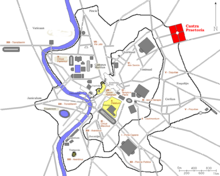Castra praetoria
Coordinates: 41 ° 54 ′ 21.1 ″ N , 12 ° 30 ′ 21.6 ″ E
The Castra praetoria were a fortified camp for the Praetorian Guard in Rome . They gave the name of today's district Castro Pretorio .
history
The castra praetoria were built by the Roman emperor Tiberius between AD 20 and 23 at the suggestion of Seianus . In this way, the Praetorians distributed by Augustus to several locations were brought together in one place. The castra praetoria opposed the Roman tradition of a demilitarized capital and made the stationing of troops in the city visible for the first time. They were therefore originally located on one of the highest points of Rome northeast outside the city, just outside the Pomerium , but were integrated into the course of the Aurelian city wall from the year 271 . The camp existed until the dissolution of the Praetorians under Constantine in 312.
investment
The camp formed a rectangle 440 × 380 meters with rounded corners and four gates, including the north gate, the Porta Praetoriana . The north and east sides as well as parts of the south side of the surrounding wall have been preserved. Buildings in the interior that are documented by sources and inscriptions are a Martian temple , a tribunal , schola et aedicula and the armamentarium ( arsenal ). During excavations in connection with the construction of the national library between 1960 and 1966, the Tiberian gates and other barracks were discovered in the south-eastern sector . Since the subway was built from 1983 to 1985, three other structures are known. This includes a large room measuring 14.70 × 7.70 meters.
Schematic representation of the Castra praetoria on a coin of Claudius
literature
- Samuel Ball Platner , Thomas Ashby : A Topographical Dictionary of Ancient Rome . Oxford University Press, London 1929, pp. 106-107 ( online ).
- Lawrence Richardson Jr .: A New Topographical Dictionary of Ancient Rome. Johns Hopkins University Press, Baltimore 1992, pp.78f. sv Castra Praetoria .
- Elisa Lissi Caronna: Castra Praetoria In: Lexicon Topographicum Urbis Romae . Vol. 1, Qasar, Rome 1993, ISBN 88-7097-019-1 , pp. 251-254.
- Reinhard Förtsch : Castra [I 5]. C. Praetoria. In: The New Pauly (DNP). Volume 2, Metzler, Stuttgart 1997, ISBN 3-476-01472-X , Sp. 1025.
- Alexandra W. Busch : Military in Rome. Military and paramilitary units in the imperial cityscape (= Palilia vol. 20). Reichert, Wiesbaden 2011, ISBN 978-3-89500-706-4 , pp. 31-71 ( online catalog ).
Web links
- Castra Praetoria in the Arachne archaeological database
- Plan of the secured parts of the Castra praetoria
- Reconstructed plan of the Castra praetoria
Remarks
- ↑ The names castrum praetorium ( CIL 15, 07239b , CIL 15, 07239c ) and castrae praetori [ae] ( CIL 15, 07239d ) are also occasionally used. Otherwise always neuter plural, cf. such as Tacitus , Annales 4, 2 ; 13, 14 ; 15, 53 and 59 ; Suetonius , Claudius 21 ; see also Karl Ernst Georges : Detailed Latin-German concise dictionary. 8th improved and enlarged edition by Heinrich Georges . Hahnsche Buchhandlung, Hanover 1913/1918, sv Castrum II 2 a.
- ^ Cassius Dio 57, 19, 6.
- ↑ Tacitus, Annales 4, 2 ; Suetonius, Tiberius 37, 1 .
- ↑ Pliny , Naturalis historia 3, (9) 67 ; Tacitus, Annales 4, 2.
- ↑ CIL 6, 2256 .
- ↑ CIL 6, 3559 .
- ↑ CIL 6, 215 .
- ↑ CIL 6,999 ; CIL 6, 2725 ; Tacitus, Historiae 1, 38, 2.






